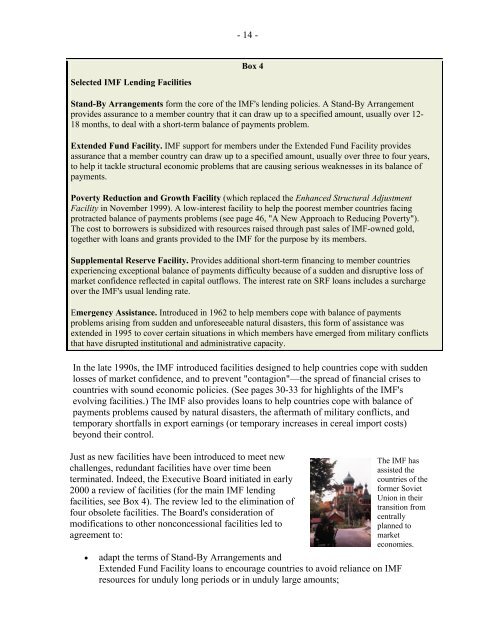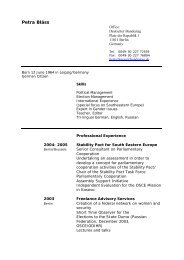What Is the International Monetary Fund? - the JVI eCampus!
What Is the International Monetary Fund? - the JVI eCampus!
What Is the International Monetary Fund? - the JVI eCampus!
Create successful ePaper yourself
Turn your PDF publications into a flip-book with our unique Google optimized e-Paper software.
Selected IMF Lending Facilities<br />
- 14 -<br />
Box 4<br />
Stand-By Arrangements form <strong>the</strong> core of <strong>the</strong> IMF's lending policies. A Stand-By Arrangement<br />
provides assurance to a member country that it can draw up to a specified amount, usually over 12-<br />
18 months, to deal with a short-term balance of payments problem.<br />
Extended <strong>Fund</strong> Facility. IMF support for members under <strong>the</strong> Extended <strong>Fund</strong> Facility provides<br />
assurance that a member country can draw up to a specified amount, usually over three to four years,<br />
to help it tackle structural economic problems that are causing serious weaknesses in its balance of<br />
payments.<br />
Poverty Reduction and Growth Facility (which replaced <strong>the</strong> Enhanced Structural Adjustment<br />
Facility in November 1999). A low-interest facility to help <strong>the</strong> poorest member countries facing<br />
protracted balance of payments problems (see page 46, "A New Approach to Reducing Poverty").<br />
The cost to borrowers is subsidized with resources raised through past sales of IMF-owned gold,<br />
toge<strong>the</strong>r with loans and grants provided to <strong>the</strong> IMF for <strong>the</strong> purpose by its members.<br />
Supplemental Reserve Facility. Provides additional short-term financing to member countries<br />
experiencing exceptional balance of payments difficulty because of a sudden and disruptive loss of<br />
market confidence reflected in capital outflows. The interest rate on SRF loans includes a surcharge<br />
over <strong>the</strong> IMF's usual lending rate.<br />
Emergency Assistance. Introduced in 1962 to help members cope with balance of payments<br />
problems arising from sudden and unforeseeable natural disasters, this form of assistance was<br />
extended in 1995 to cover certain situations in which members have emerged from military conflicts<br />
that have disrupted institutional and administrative capacity.<br />
In <strong>the</strong> late 1990s, <strong>the</strong> IMF introduced facilities designed to help countries cope with sudden<br />
losses of market confidence, and to prevent "contagion"—<strong>the</strong> spread of financial crises to<br />
countries with sound economic policies. (See pages 30-33 for highlights of <strong>the</strong> IMF's<br />
evolving facilities.) The IMF also provides loans to help countries cope with balance of<br />
payments problems caused by natural disasters, <strong>the</strong> aftermath of military conflicts, and<br />
temporary shortfalls in export earnings (or temporary increases in cereal import costs)<br />
beyond <strong>the</strong>ir control.<br />
Just as new facilities have been introduced to meet new<br />
challenges, redundant facilities have over time been<br />
terminated. Indeed, <strong>the</strong> Executive Board initiated in early<br />
2000 a review of facilities (for <strong>the</strong> main IMF lending<br />
facilities, see Box 4). The review led to <strong>the</strong> elimination of<br />
four obsolete facilities. The Board's consideration of<br />
modifications to o<strong>the</strong>r nonconcessional facilities led to<br />
agreement to:<br />
The IMF has<br />
assisted <strong>the</strong><br />
countries of <strong>the</strong><br />
former Soviet<br />
Union in <strong>the</strong>ir<br />
transition from<br />
centrally<br />
planned to<br />
market<br />
economies.<br />
• adapt <strong>the</strong> terms of Stand-By Arrangements and<br />
Extended <strong>Fund</strong> Facility loans to encourage countries to avoid reliance on IMF<br />
resources for unduly long periods or in unduly large amounts;



